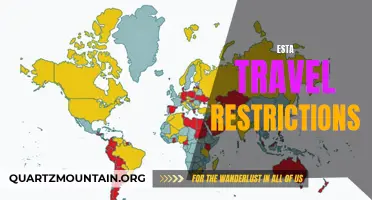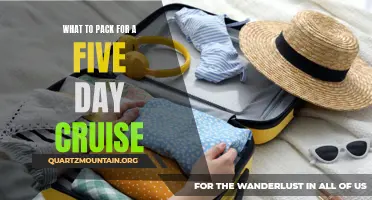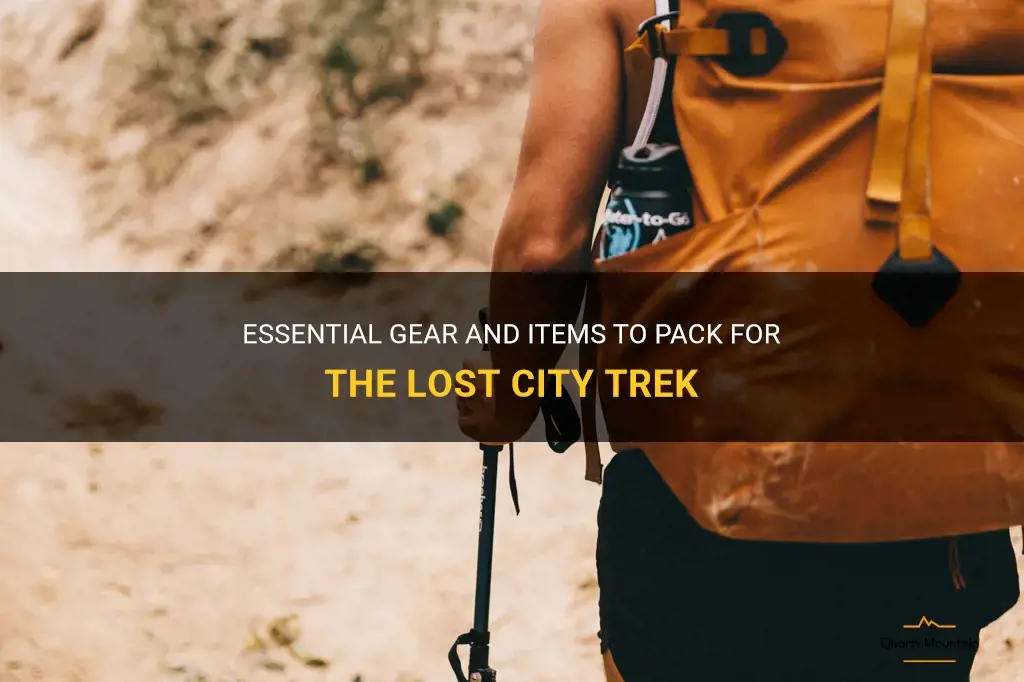
The Lost City Trek in Colombia is a once-in-a-lifetime adventure that takes you through dense jungles, steep mountains, and ancient ruins. But before you embark on this epic journey, it's crucial to make sure you have the right gear and items to accompany you along the way. From sturdy hiking boots to bug spray, we've compiled a list of essential gear and items that will help make your Lost City Trek experience a memorable and comfortable one. So tighten your backpack straps and get ready to explore the wonders of the Lost City with confidence!
| Characteristics | Values |
|---|---|
| Duration | 5 days/4 nights |
| Difficulty | Moderate |
| Elevation | 880 meters to 1,200 meters |
| Temperature | 28°C (82°F) in the day, 10°C (50°F) at night |
| Rainfall | Rainy season from September to November |
| Clothing | Lightweight, quick-drying |
| Footwear | Sturdy hiking boots |
| Sleeping arrangements | Hammocks or tents |
| Food and water | Provided by tour operator |
| Insect repellent | Highly recommended |
| Sunscreen | SPF 30+ |
| First aid kit | Essential medications and band-aids |
| Cash | Colombian pesos |
| Passport | Original document and a photocopy |
| Camera | Waterproof and shockproof |
| Snacks | Energy bars, dried fruits, nuts |
| Water bottle | Reusable and refillable |
| Headlamp | Hands-free lighting |
| Toilet paper | Biodegradable |
| Personal toiletries | Travel-sized shampoo, soap, toothbrush |
| Rain gear | Poncho or rain jacket |
| Backpack | 25-30 liters |
| Hat | Wide-brimmed hat to protect from the sun |
| Sleeping bag | Lightweight and compact |
| Hiking poles | Recommended for extra support |
| Binoculars | Optional but useful for birdwatching |
| Travel insurance | Recommended |
What You'll Learn
- What are the essential items to pack for the Lost City Trek?
- Are there any specific clothing items or gear that are recommended for the Lost City Trek?
- Is it necessary to bring camping equipment, or are there accommodations along the trail?
- Are there any restrictions on what can be packed for the Lost City Trek?
- What kind of food and water should be packed for the trek?

What are the essential items to pack for the Lost City Trek?
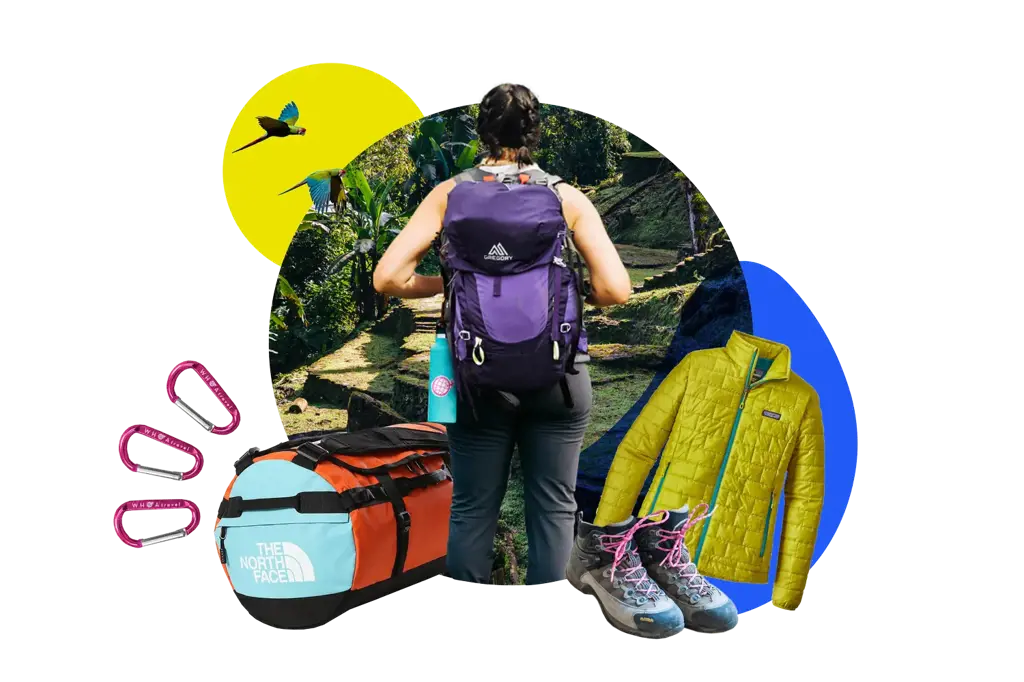
The Lost City Trek is a popular hiking trail located in the Sierra Nevada de Santa Marta mountain range in Colombia. This challenging trek takes hikers through dense jungles, across rushing rivers, and up steep mountainsides to reach the ancient ruins of the Ciudad Perdida, or Lost City. As with any multi-day hike, it is crucial to pack the right gear to ensure a safe and enjoyable experience. Here are some essential items to pack for the Lost City Trek:
- Backpack: A good quality backpack is essential for carrying all your gear during the trek. Look for a backpack with a capacity of 40-60 liters, as you will need to carry enough food, water, and clothing for the duration of the hike.
- Hiking boots: Invest in a sturdy pair of hiking boots that provide good ankle support and grip. The terrain on the Lost City Trek can be rough and slippery, so having proper footwear is crucial for avoiding injuries.
- Quick-dry clothing: The Lost City Trek is a hot and humid hike, so it is important to pack lightweight, breathable, and quick-dry clothing. Avoid cotton, as it retains moisture and can cause discomfort and chafing. Instead, opt for synthetic or merino wool materials that wick away moisture and dry quickly.
- Rain gear: The weather in the Sierra Nevada de Santa Marta can be unpredictable, so it is essential to pack a waterproof jacket and pants. Look for gear that is lightweight and easily packable to save space in your backpack.
- Sleeping bag: Most tour operators provide sleeping bags for the Lost City Trek, but it is always a good idea to bring your own. Look for a lightweight and compact sleeping bag that is suitable for the expected temperatures during your hike.
- Insect repellent: The jungle environment of the Lost City Trek is teeming with mosquitoes and other insects. Pack a good quality insect repellent to protect yourself from bites and potential diseases.
- First aid kit: It is important to carry a basic first aid kit with you during the trek. Include items such as band-aids, antiseptic wipes, pain relievers, and any personal medications you may need.
- Water purifier: Clean drinking water is not readily available along the trek, so it is important to have a reliable water purifier with you. Look for a lightweight and portable option that can remove bacteria and viruses from natural water sources.
- Headlamp: A headlamp is essential for navigating the trail in the early morning or evening when it may be dark. Choose a lightweight and durable headlamp that has a long battery life.
- Snacks and food: While meals are usually provided by tour operators, it is a good idea to carry some extra snacks and energy bars to keep you fueled during the trek. Pack lightweight and non-perishable items that are high in calories and nutrients.
Remember to pack light and only bring the essentials to ensure that your backpack is not too heavy. It is also important to do thorough research and consult with your tour operator for any specific gear requirements or recommendations for the Lost City Trek. By packing the right gear, you can fully enjoy the beauty and adventure of this remarkable hike.
Essential Items to Pack for a Memorable Summer Trip to Mount Rushmore
You may want to see also

Are there any specific clothing items or gear that are recommended for the Lost City Trek?
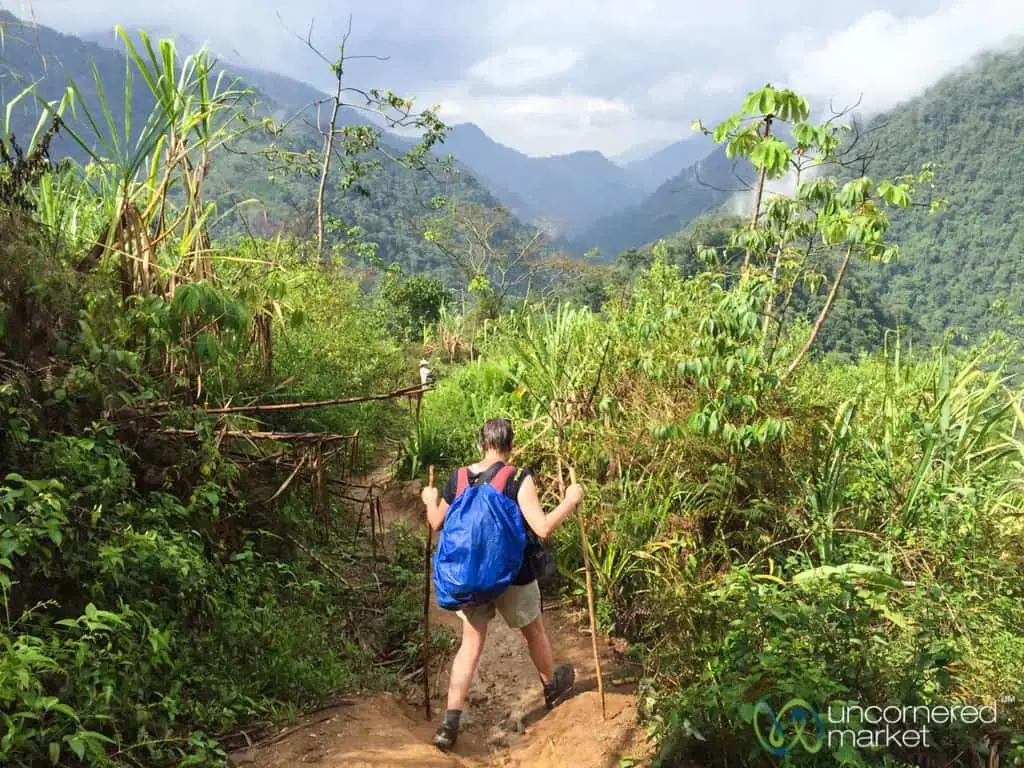
The Lost City Trek in Colombia is a challenging yet rewarding experience that takes hikers through the lush Sierra Nevada Mountains to the ancient ruins of Ciudad Perdida, also known as the Lost City. As this trek is quite demanding, it is essential to come prepared with the right clothing and gear to ensure a safe and comfortable journey.
When embarking on the Lost City Trek, it is crucial to have proper hiking boots. The terrain can be rugged and slippery, so sturdy footwear with good ankle support is essential. Make sure your boots are broken-in before the trek to avoid blisters and discomfort along the way.
In addition to hiking boots, lightweight and breathable clothing is a must. The Sierra Nevada Mountains can be hot and humid, so it is important to choose materials that wick away moisture and allow for ventilation. Opt for quick-drying fabrics that will keep you comfortable during long days of walking.
Here is a list of essential clothing items and gear to pack for the Lost City Trek:
- Hiking pants or shorts: Choose lightweight, quick-drying pants or shorts that provide freedom of movement and protection from the elements. Avoid cotton as it retains moisture and can lead to discomfort.
- Moisture-wicking shirts: Opt for shirts made of synthetic materials that wick away sweat and keep you dry during the trek. Long-sleeved shirts can also protect you from sunburn and insect bites.
- Sun hat: Protect your face and neck from the sun's harsh rays with a wide-brimmed hat. Look for a hat with breathable fabric and a chin strap to ensure it stays in place during windy conditions.
- Rain jacket: The weather in the Sierra Nevada Mountains can be unpredictable, so it is important to pack a lightweight, waterproof rain jacket. Choose a jacket with breathable fabric to prevent overheating.
- Swimming gear: Along the Lost City Trek, you will have the opportunity to take refreshing dips in rivers and waterfalls. Pack a swimsuit or quick-dry shorts for these occasions.
- Hiking socks: Invest in a few pairs of moisture-wicking hiking socks to keep your feet dry and blister-free. It is recommended to bring extra pairs to change into during the trek.
- Backpack: Choose a comfortable backpack with a capacity of around 30-40 liters to carry your essentials during the trek. Look for a backpack with good back support and adjustable straps for a customized fit.
- Water bottle: Staying hydrated is essential during the Lost City Trek. Bring a reusable water bottle and refill it at the designated water sources along the trail.
- Snacks: Pack lightweight, high-energy snacks such as nuts, granola bars, and dried fruits to fuel your body during the trek.
- Insect repellent: The Sierra Nevada Mountains are home to various insects, including mosquitoes. Protect yourself from bites by applying a reliable insect repellent.
- First aid kit: It is always wise to have a basic first aid kit on hand for any unexpected injuries or ailments. Include band-aids, antiseptic wipes, pain medication, and any personal medications you may need.
Remember, the Lost City Trek requires a good level of fitness and stamina. It is essential to train and prepare your body before attempting the trek to avoid injuries and fatigue. Consult with a medical professional if you have any health concerns or conditions that may affect your ability to complete the trek.
By packing the right clothing items and gear, you can fully enjoy the Lost City Trek and have a memorable adventure in the beautiful Sierra Nevada Mountains of Colombia.
Essential Items to Pack for Hawaii Vacation with a Toddler
You may want to see also

Is it necessary to bring camping equipment, or are there accommodations along the trail?
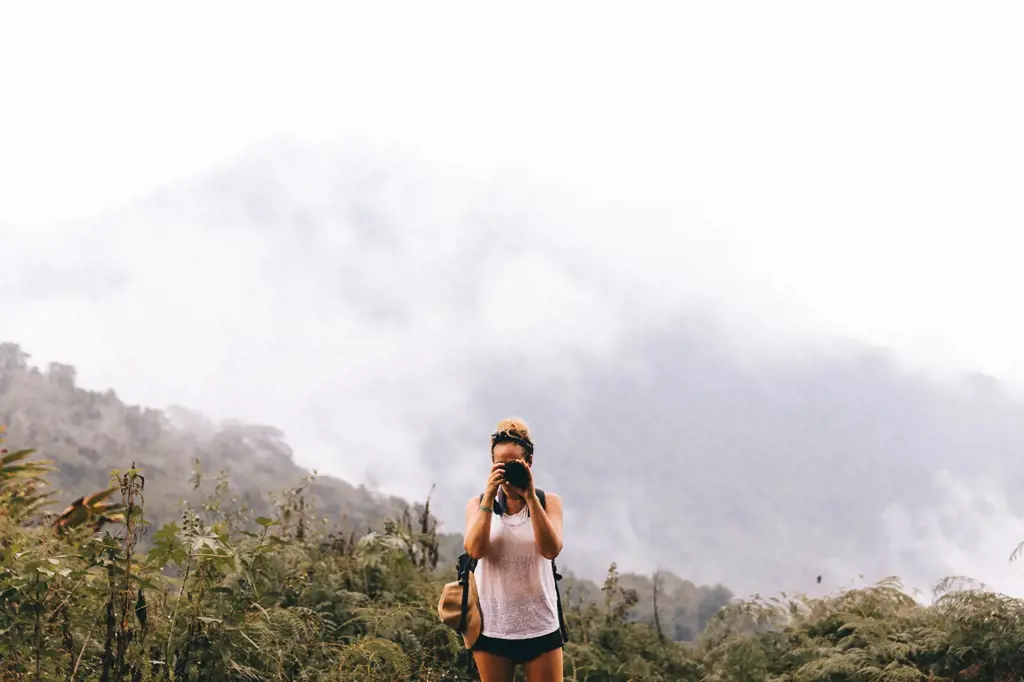
When planning a hiking or backpacking trip, one of the key considerations is whether to bring camping equipment or rely on accommodations along the trail. This decision can greatly impact the overall experience and logistics of the trip. In this article, we will explore the factors to consider when making this decision and provide some examples to help you decide what is best for your specific situation.
Firstly, it is important to research the specific trail you will be hiking. Some trails, especially popular ones, may have designated camping areas or huts along the route. These accommodations often provide basic facilities such as toilets, cooking areas, and sleeping arrangements. Knowing if these amenities are available can help you determine whether you need to bring your camping gear or not.
Additionally, the duration of your trip plays a significant role in deciding whether to bring camping equipment or not. If you are planning a multi-day hike, having your own camping gear will provide you with the flexibility to camp wherever you choose. This can be particularly important if you want to experience the solitude and freedom of camping in the wilderness. On the other hand, if you are only planning a day hike or a short overnight trip, relying on accommodations along the trail might be more convenient and practical.
Another factor to consider is the level of comfort you desire during your trip. Camping gear allows you to have a personal and private sleeping space, which can be important for a good night's rest. Accommodations along the trail may have limited space or shared sleeping quarters, which may not be ideal for everyone. Additionally, if you have specific dietary requirements or preferences, bringing your own cooking equipment will give you more control over your meals.
Furthermore, consider the weather conditions you may encounter on your hike. Camping equipment is designed to provide protection from the elements, such as rain, wind, and cold temperatures. If the weather forecast indicates challenging conditions, it is essential to have the appropriate gear to ensure your safety and comfort. Accommodations along the trail may not always offer the same level of protection.
To help you make the best decision, let's consider a few examples. Suppose you are planning to hike the Appalachian Trail, a well-known trail in the United States. The trail has various accommodations, including shelters and campsites, along its 2,190-mile stretch. Many hikers choose to bring their camping gear to have more flexibility and independence during their journey.
Now, let's say you are planning a hike in a national park with designated camping areas. Some national parks, such as Yosemite National Park in California, offer campsites with stunning views and basic facilities. In this case, bringing camping equipment might be unnecessary as the park provides suitable accommodations.
In conclusion, the decision of whether to bring camping equipment or rely on accommodations along the trail depends on several factors. Consider the availability of accommodations, the duration of your trip, the level of comfort you desire, and the weather conditions you may encounter. By considering these factors and researching your specific trail, you can make an informed decision that will enhance your hiking experience. Ultimately, both options have their merits, and the choice will depend on your preferences and the specific requirements of your trip.
Essential Items to Pack for Your Trip to Vietnam
You may want to see also

Are there any restrictions on what can be packed for the Lost City Trek?
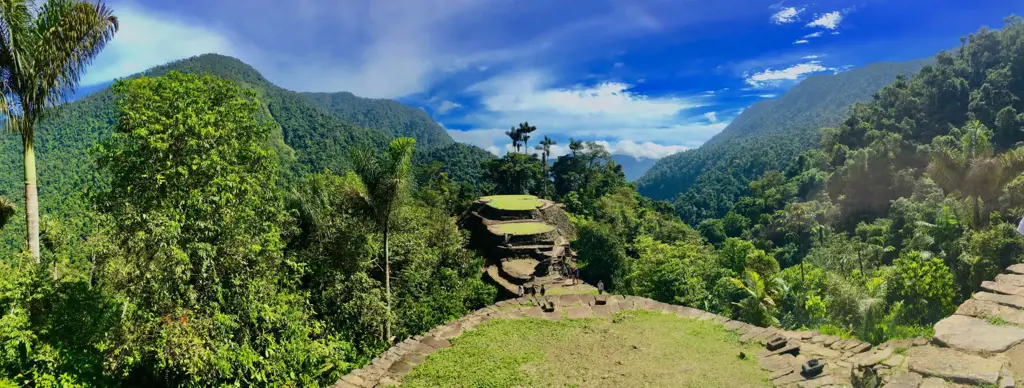
When preparing for the Lost City Trek, it is important to keep in mind that there are restrictions on what can be packed. These restrictions are in place to protect the environment and ensure the safety of the hikers. In this article, we will explore the specific restrictions that apply to the Lost City Trek and provide some tips on how to pack accordingly.
One of the main restrictions for the Lost City Trek is the weight limit for your backpack. Each hiker is only allowed to carry up to 10 kilograms (22 pounds) of personal belongings. This weight limit includes your clothes, toiletries, sleeping bag, and any other personal items you might want to bring. It is important to pack light and only bring the essentials to stay within the weight limit and avoid unnecessary strain on your body during the trek.
Another restriction is the prohibition of single-use plastic bottles and bags. To reduce waste and protect the environment, it is recommended to bring a reusable water bottle and a reusable bag for any trash you may generate during the trek. There are refill stations along the trek where you can refill your water bottle with purified water, so there is no need to bring disposable bottles.
When it comes to clothing, it is essential to pack appropriate gear for the tropical conditions of the Lost City Trek. It is recommended to bring lightweight, breathable, and quick-drying fabrics, such as moisture-wicking shirts and pants. It is also important to pack layers, as the temperature can vary throughout the day, with hot and humid conditions during the day and cooler temperatures at night. Don't forget to pack a rain jacket or poncho, as rain is common in the region.
In terms of footwear, it is crucial to have comfortable and sturdy hiking shoes or boots that provide good ankle support. The terrain during the Lost City Trek can be challenging, with steep inclines, rocky paths, and river crossings, so having the right footwear is essential for your safety and comfort.
In addition to the restrictions on what you can pack, it is also important to consider the cultural sensitivities of the indigenous communities you will encounter during the trek. It is recommended to dress modestly and respectfully and to avoid wearing revealing clothing. Also, remember to bring a hat, sunglasses, and sunscreen to protect yourself from the strong tropical sun.
To summarize, when packing for the Lost City Trek, it is important to consider the weight restrictions, avoid single-use plastics, pack appropriate clothing for the tropical conditions, bring sturdy hiking shoes, and respect the cultural sensitivities of the indigenous communities. By following these guidelines, you can ensure a safe and enjoyable trekking experience while minimizing your impact on the environment.
Essential Items to Pack for a Glamping Adventure
You may want to see also

What kind of food and water should be packed for the trek?
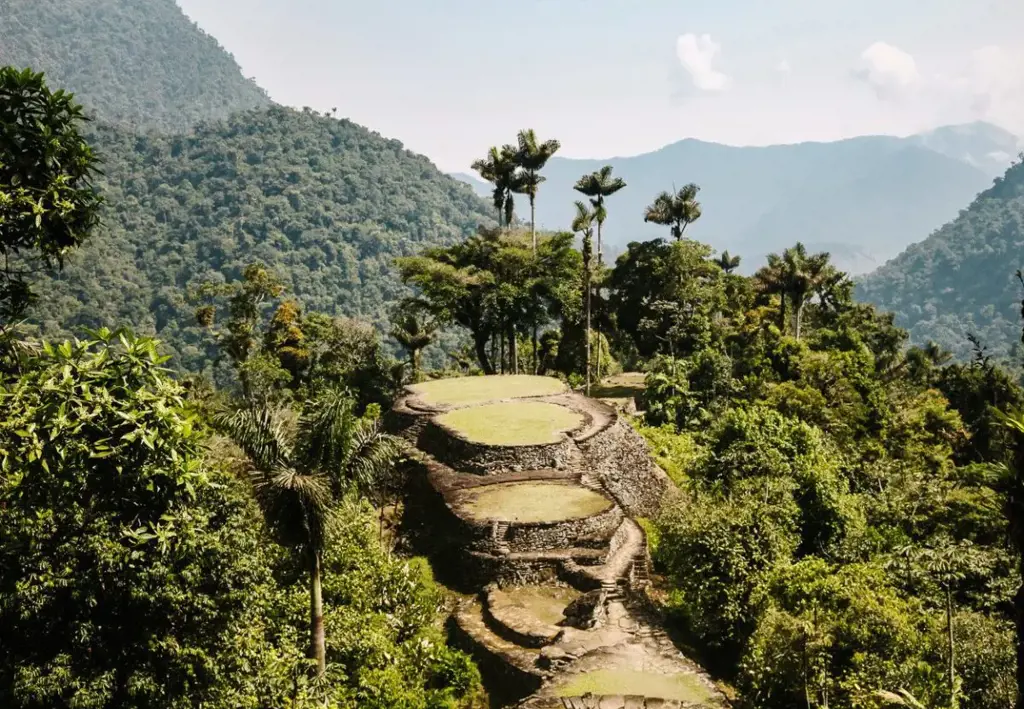
When preparing for a trek, it is crucial to pack the right kind of food and water to ensure that you have enough energy and hydration to complete the journey. The type of food and water you pack will depend on the duration and intensity of the trek, as well as your personal preferences and dietary restrictions.
Water is essential for any trek, as dehydration can lead to fatigue, dizziness, and even more serious health issues. It is recommended to bring at least 2 liters of water per day for shorter treks and up to 4 liters per day for longer, more strenuous treks. It is crucial to pack water in leak-proof containers and consider using a water purification system or bring water purification tablets to ensure the availability of safe drinking water throughout the trek.
In terms of food, it is important to pack lightweight, non-perishable, and nutrient-dense options that provide sustained energy. Some popular choices for trekking food include:
- Trail mix: A mix of nuts, dried fruits, and seeds provides a good balance of healthy fats, protein, and carbohydrates that can provide a quick burst of energy.
- Energy bars: Look for bars that are high in protein and complex carbohydrates to keep you nourished and satisfied during the trek. Avoid bars with excessive sugar content, as they can lead to energy crashes later on.
- Dehydrated meals: These lightweight meals are a convenient option for longer treks. They can be easily rehydrated with boiling water, providing a hot and filling meal at the end of a tiring day.
- Nut butter: Peanut butter or other nut butter spreads are an excellent source of healthy fats and proteins. They can be spread on crackers or used as a dip for fruits and vegetables, providing a satiating and energizing snack.
- Instant oatmeal: Quick and easy to prepare, instant oatmeal is a great option for breakfast on the trek. It is filling, nutrient-dense, and provides a good balance of carbohydrates and fiber.
When choosing food for the trek, it is important to consider any dietary restrictions or allergies you may have. Ensure that you have enough food to last the entire duration of the trek, and consider packing a little extra in case of unexpected delays or emergencies.
Additionally, remember to pack food in durable, airtight containers to protect it from moisture, pests, and spoilage. Use resealable bags or waterproof containers to keep your food fresh and safe.
Lastly, be mindful of leaving no trace. Pack out any waste or leftover food and dispose of it properly. Minimizing our impact on the environment is crucial for preserving the beauty of the trekking trails for future generations.
Overall, packing the right kind of food and water for a trek is essential for ensuring your energy, hydration, and nutrition needs are met. By planning ahead and choosing lightweight, non-perishable, and nutrient-dense options, you can enjoy a safe and fulfilling trekking experience.
Essential Items to Pack for Your September Trip to Bar Harbor Maine
You may want to see also
Frequently asked questions
When packing for the Lost City Trek, it's important to pack light and only bring the essential items. Some things you should include are comfortable hiking shoes, clothing suitable for warm and humid weather, a hat and sunscreen to protect yourself from the sun, a lightweight and waterproof backpack, a refillable water bottle, insect repellent, a sleeping bag, a towel, and personal toiletries. It's also a good idea to pack some snacks and a basic first aid kit with items such as band-aids, pain relievers, and any necessary prescription medications.
While some tour companies or local hostels may offer gear rentals, it's best to bring your own equipment for the Lost City Trek. Rental gear may not always be in the best condition or fit properly, which could lead to discomfort or injury during the trek. It's recommended to invest in your own gear, especially essentials like hiking shoes, backpack, and sleeping bag, to ensure you have the right fit and quality for the trek.
There are some restrictions on what you can bring for the Lost City Trek due to environmental regulations and the cultural significance of the area. It's important to avoid bringing any single-use plastics such as water bottles, plastic bags, or straws. Instead, opt for reusable options. Additionally, leave any valuables or non-essential items behind, as they can be a burden to carry and could get damaged or lost during the trek. Follow the guidelines provided by your tour operator or local guides to ensure you adhere to any specific restrictions in place for the trek.




